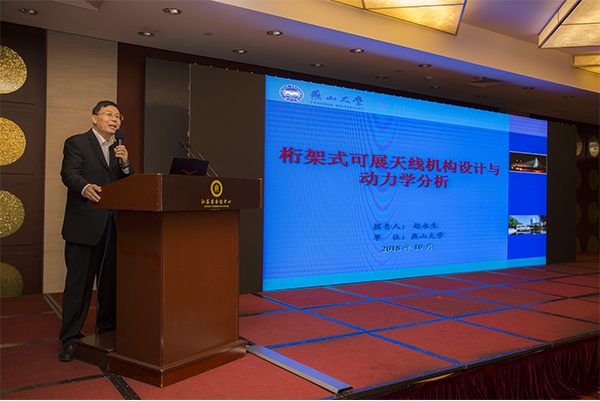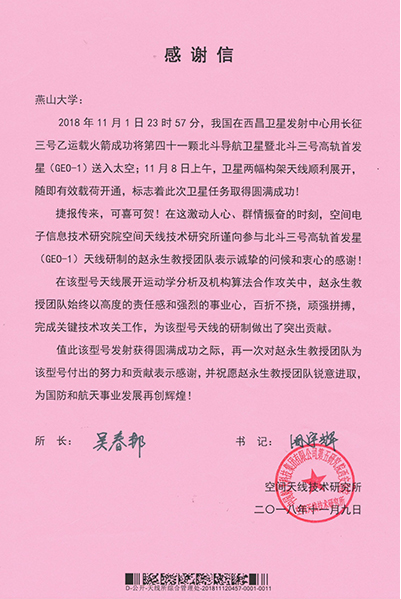[News from the News Center] Several days ago,China Academy of Space Technology(CAST) - Xi’an Institute of Space Radio Technologysent a letter of thanks toYSU expressinggratitudetoProf.Zhao Yongshengand histeam for theiroutstanding contribution of the launchingprogramof the first BDS-3 GEO satellite.
At 23:57, November 1, 2018, the 41stBDS satellite(the first BDS-3 GEO satellite)was successfully launched onboard a Long March 3B rocket at Xichang Satellite Launch Center. On the morning of November 8, the two satellite antennas were successfully deployed, and the payload was opened. Thestructure of deployable satellite antenna is developed byCAST - Xi’an Institute of Space Radio Technology, andYSUProf.Zhao Yongshengas well as histeamis involved initsresearch and development.

The 41stBDS satellitewas successfully launched. (Photo from People.cn)
The BeiDou Navigation Satellite System (BDS),independently constructed and operated by China, is considered as thefourth global navigation satellite systemafterthe United States’ Global Positioning System (GPS),Russia’s Global Navigation Satellite System(GLONASS)the European Union’s Galileo Satellite Navigation System.
Chinahascompletedthe construction of BDS-1 and providedservices to the whole country by the end of 2000, andcompletedthe construction of BDS-2 and providedservices to the Asia-Pacific region by the end of 2012.BDS-3tobecompleted is designed toprovide services worldwide.The 41stBDS satelliteisthe first BDS-3 satellite in high orbit, about 36,000 km above the Earth. Itis called“BDS-3 GEO satellite”because itoperatesona geostationary orbit.
The satellite-borne deployable antenna is one of the key payloads of the satellite, which is of significance incommunication and data transmission between the satellitesin orbitand the ground base station. Whether it can be successfully deployed is a key factor determining the success or failure of the satellite. The antennaadopted inthis satellite is a multi-closed-loop coupling mechanism. It is the most complex type of space mechanism. The innovative design,mechanism analysis and optimization of the structure are more complexthanthose ofthe traditional parallel mechanism. Prof.Zhao Yongshengand histeam have been working with theInstitute of Space Radio Technologysince 2014, and they haveaccumulatedprofoundacademic strengthinmechanism. Together with the research group oftheInstitute of Space Radio Technology,Professor Yao Jiantao and Associate Professor Xu Yundoufrom this teamled theirresearchgroupto make breakthrough inthe configuration synthesis,deployment kinematics, anddeployment dynamicsof thesatellite-borne deployable antenna, and theyinnovatively established a theoretical system of the configuration synthesis and mechanism analysis, layingtheoretical and technological foundationfor further research and development ofhigher-level satellite-borne deployable antennas.In thecooperative researchof thekinematics analysis and mechanism algorithm, Professor Zhaoand histeam havealwayskepta high sense of responsibility and a strong sense of professionalism,and theycompleteda series of key technical researchwithperseveranceandhard work, makingoutstanding contributionsto the successful developmentofthis type of antenna.

Prof. Zhao gives a key-note speech at the 3rddeployable space structureacademic conference.(Photo fromSchool of Mechanical Engineering)
Before the research of thedeployable antennaof theBDS-3 GEOsatellite, Prof. Zhao and his teamhave conducted cooperationwiththe 54thResearch Institute of China Electronics Technology Group Corporation(CETC54) in theaccurate adjustment system for sub-reflectorpose of Shanghai 65m radio telescope (Tianma Telescope) andintheFive-hundred-meterApertureSphericalTelescope(FAST),andhave cooperationwith CETC14in AirborneActivePhasedArrayWide-angle Domain Fire-controlRader. Thedeployable antennais anotherbreakthrough in the aerospace industryof Prof. Zhao Yongsheng and his team, markingthesuccessful application oftheirspace multi-closed-loop special robots inaerospacedeployable antennas.
[Translated by Xing Tong]
